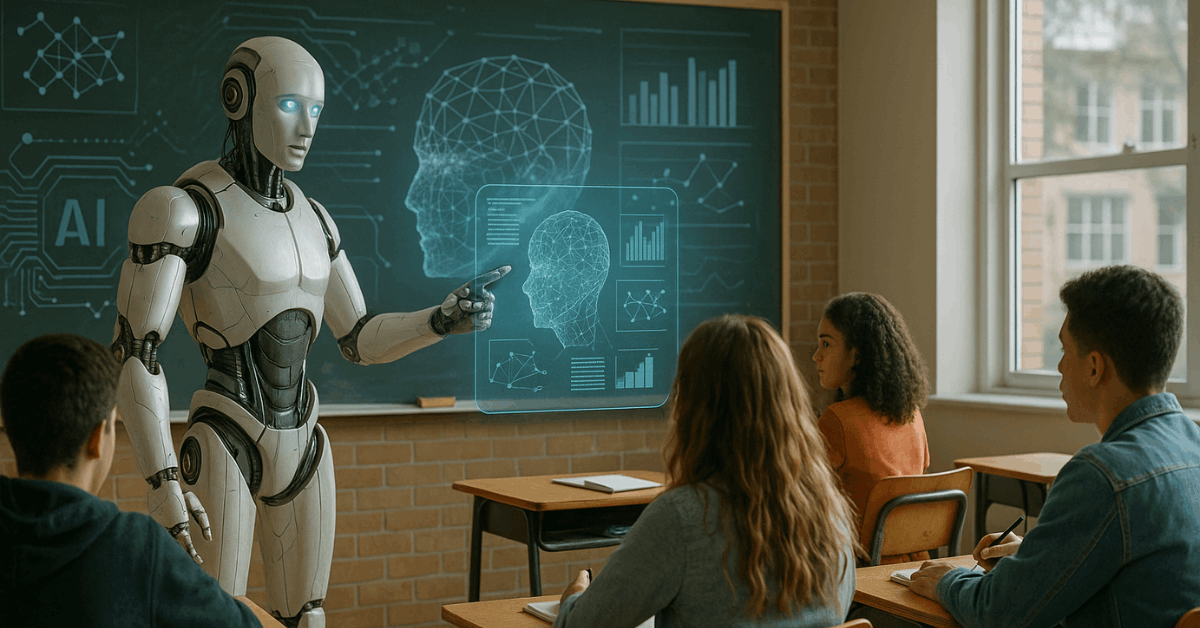Artificial Intelligence is becoming a central force in modern education. It shapes how students learn, how teachers instruct, and how schools operate.
This article will explore how artificial intelligence will change education through smarter systems and improved personalization. These changes will affect both learning quality and access.
AI in Personalized Learning
AI adapts learning experiences based on each student’s progress. It focuses on delivering what the student needs most at the right time.

Customizing Lessons Based on Student Performance
AI platforms use performance data to adjust lesson difficulty. When a student struggles, it offers easier examples and repeats key concepts.
If a student excels, the system moves forward. This helps reduce boredom and stress. You get lessons that match your level instantly. Learning becomes more efficient.
Learning Path Recommendations
AI detects which areas need improvement. It suggests targeted modules, videos, or quizzes. Instead of following a rigid syllabus, you follow a custom path.
This boosts understanding and confidence. You’re always working on what matters most. It saves time and improves retention.
AI as a Virtual Teaching Assistant
AI doesn’t replace your teacher, but it gives you support around the clock. It also helps manage repetitive teaching tasks.
24/7 Support for Students
AI chatbots answer questions instantly, no matter the time. You can ask for definitions, examples, or steps to solve problems.
There’s no waiting for the next class. This helps reinforce learning after school. You stay engaged even outside the classroom. Learning becomes more accessible.
Automated Feedback on Assignments
AI tools can mark answers and give instant feedback. You find out what you did right or wrong immediately. This speeds up your learning process.
It helps avoid repeating the same mistakes. Teachers also save time for more complex tasks. Everyone benefits.
Smart Content Creation
AI can create study materials automatically. This includes quizzes, notes, and summaries.
Automatic Generation of Practice Questions and Summaries
AI reviews textbooks or lecture notes and generates key points. It turns chapters into summaries or creates sample questions.
This helps with quick reviews before exams. You don’t need to spend hours preparing notes. The system does it for you. It saves effort and improves focus.
Voice-to-Text and Translation Tools
Speech recognition tools convert spoken words into text. This helps students who struggle with writing or need transcripts.
Translation tools also support learners who speak different languages. AI ensures everyone gets the same access to information. Inclusion improves in classrooms. Language is no longer a barrier.
Efficient Grading and Evaluation
AI reduces the time spent on checking papers. It helps teachers focus on mentoring and planning.
Grading Objective Exams
AI can score multiple-choice, true/false, and fill-in-the-blank questions. It works fast and avoids bias. Results are accurate and consistent.
Students get their scores right away. Teachers don’t have to spend hours grading. Time is better used elsewhere.
Analyzing Essay Content
Some AI tools scan essays for structure, clarity, and grammar. They also check for plagiarism. This helps students learn how to write better.
Teachers can use the analysis to give detailed advice. The process is fair and fast. Learning quality improves.
Improving Teacher Workflows
Teachers benefit from AI just as much as students. Many tasks can now be automated or improved.
Automating Routine Tasks
AI schedules lessons, sets reminders, and manages classroom records. Teachers no longer have to do everything manually. This reduces workload and errors.
Energy can be directed to interactive learning. Teachers gain more control over their time. Students enjoy more attention.
Insights for Better Teaching Strategies
AI identifies where students often make mistakes. It highlights which topics confuse them the most. Teachers use this data to adjust lesson plans.
They focus more on what students actually need. This results in improved teaching quality. Everyone benefits from the insights.
AI-Driven Adaptive Learning Platforms
Adaptive learning adjusts content based on real-time feedback. It makes learning dynamic and effective.
Platforms That Adjust in Real Time
When students struggle, AI slows down the pace. If they understand fast, it pushes ahead. This keeps learning in the ideal zone.
It prevents frustration or boredom. Lessons always match your current ability. Engagement stays high.
Gamified Learning Based on Student Preferences
AI helps create fun, game-like content. Points, badges, and levels are added to motivate learning. It makes lessons enjoyable and competitive.
Students stay focused for longer. Progress feels rewarding. Learning becomes a challenge, not a chore.
Remote Learning and Virtual Classrooms
AI strengthens online education tools. It helps both students and teachers during remote learning.
AI-Powered Attendance and Participation Tracking
AI tracks who attends and who joins class discussions. It measures attention levels too.
Teachers can follow up with students who miss sessions. Students stay accountable. Monitoring improves discipline. Class performance gets better.
Language Recognition for International Classes
Real-time translation tools allow students from different countries to learn together. Voice recognition helps with accents and pronunciation.
Language support makes everyone feel included. Learning becomes global. AI makes cross-border education easier. Communication barriers are reduced.
Predictive Analytics for Student Success
AI can predict outcomes based on student behavior. Schools can act early to improve performance.
Identifying At-Risk Students Early
AI flags students who miss assignments or perform poorly. It alerts teachers so they can intervene quickly.
Support is provided before failure happens. This reduces dropout rates. Students feel supported. Schools become more proactive.
Forecasting Performance Trends
By analyzing grades, attendance, and activity, AI predicts final results. Schools use this data to prepare extra resources.

Students get more help where needed. Teachers know what to expect. Everyone can plan better. Education becomes more strategic.
AI and Special Education
AI tools make learning accessible to all students. This includes those with disabilities or learning difficulties.
Tools for Students with Disabilities
Speech-to-text helps those with writing problems. AI readers assist visually impaired students.
Customized learning speeds support students with ADHD or autism. Everyone gets the support they need. AI promotes equality in learning. No one is left behind.
More Accessible Content Formats
AI turns written lessons into audio, video, or interactive formats. Students choose the format that works best for them.
This increases comprehension. It also helps students with reading challenges. Learning becomes easier. Education reaches more people.
Ethical Concerns and Data Privacy
Using AI means collecting a lot of student data. This raises concerns about safety and fairness.
Student Data Protection
Schools must ensure that data is secure and encrypted. AI systems should only use necessary information.
Parents must give consent when required. Transparency in data use is essential. Trust must be earned. Student privacy should never be compromised.
Bias in Algorithms
AI tools can inherit bias from their creators or datasets. If not addressed, this leads to unfair outcomes. Schools should monitor and test systems regularly.
Developers must use diverse datasets. Fairness in education depends on this. Equal access must be guaranteed.
Preparing Educators for AI Integration
Teachers need to understand how to use AI tools effectively. Training and support are key.
Training Programs for Teachers
Courses and workshops help teachers learn AI basics. Schools should offer regular upskilling sessions. Teachers must feel confident with the tools.
Support from tech staff is important. Knowledge removes fear. Confidence improves implementation.
Creating AI-Aware School Policies
Clear rules guide how AI is used in schools. This includes what tools are allowed and how data is handled. Policies ensure fairness and accountability.
Teachers and students know their rights. It builds a safe learning environment. Structure leads to consistency.
Limitations of AI in Education
AI is powerful, but it has clear limits. It should support, not replace, human interaction.
Lack of Human Emotion and Intuition
AI doesn’t understand emotions or personal situations. It can’t motivate students the way teachers can. Emotional support remains human work.
Relationships are key in learning. Machines can’t replace empathy. Human contact is still essential.
Overreliance on Automation
If you depend too much on AI, critical thinking may drop. Students might stop learning how to solve problems. It’s important to balance automation with real effort.
Teachers must still guide discussion and creativity. Machines do tasks, not thinking. Learning must stay active.
Future Outlook for AI in Education
AI will keep growing and evolving. Schools worldwide are expected to adopt more of it.
AI Integration in Developing Countries
AI tools can bring education to remote areas. Offline solutions help where internet is limited.
Basic learning can be delivered affordably. This reduces education gaps. Technology becomes a bridge. More students get access.
Continuous Evolution of AI Tools
AI will get smarter with more data and user feedback. Systems will adapt to more learning styles.
Integration with other tech will expand capabilities. The goal is better outcomes for everyone. Progress is ongoing. The classroom is changing.
Embracing the Future of AI in Education
Artificial Intelligence is transforming classrooms, tools, and how people learn. The shift shows exactly how artificial intelligence will change education in the years ahead.
Schools must focus on fairness, access, and smart implementation. Those prepared will lead in shaping the future of learning.



